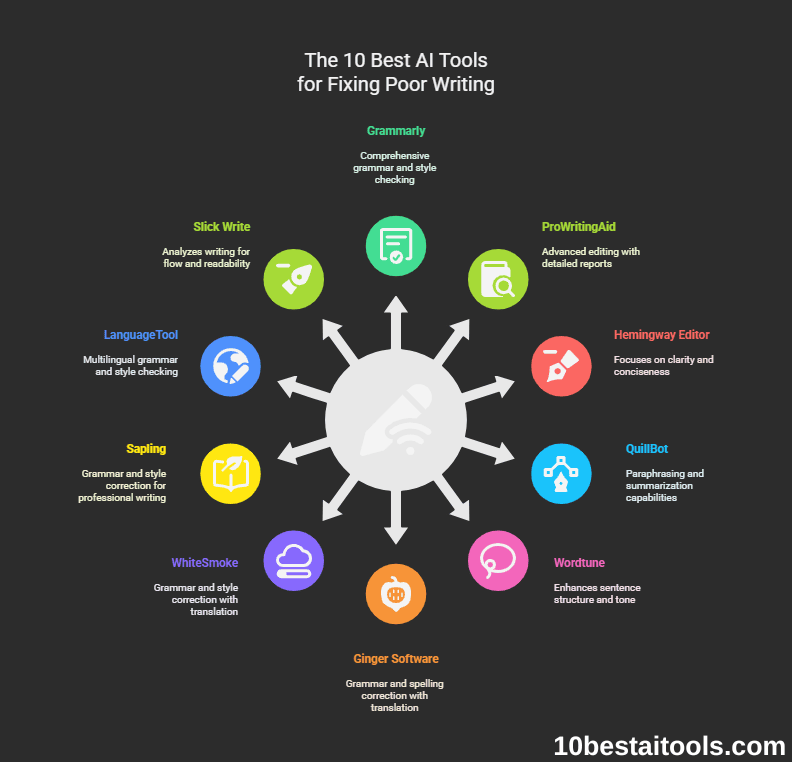Transform Your Writing from Rough to Refined in Seconds with AI
We’ve all been there: staring at a draft that almost works but feels clunky, riddled with awkward phrases, vague tone, or embarrassing typos. Maybe it’s a critical email to your boss, a blog post that’s just not clicking, or a college essay that needs polish. Hours of editing later, you’re still unsure if it’s truly clear or professional. Enter AI Tools for Fixing Poor Writing—your 24/7 editor that fixes grammar, sharpens tone, and boosts clarity in seconds. In this guide, we’ll break down the top 10 AI tools to rescue your writing, along with pros, cons, pricing, and tips to pick the right one for you.
Comparison Table: AI Tools for Fixing Poor Writing at a Glance
| Tool | Key Features | Starting Price |
|---|---|---|
| Grammarly | Grammar, tone, plagiarism checks, browser extension | Free; $12/month |
| ProWritingAid | In-depth style reports, integrations | Free; $10/month |
| Hemingway Editor | Readability focus, bold highlights | $19.99 (one-time) |
| QuillBot | Paraphrasing, summarizer, Chrome extension | Free; $10/month |
| Wordtune | Tone adjustments, sentence rewriting | Free; $10/month |
| Ginger Software | Translation, text reader, personal trainer | $13.99/month |
| WhiteSmoke | Templates, multilingual support | $5/month |
| Sapling | Short-form content focus, CRM integrations | Free; $25/month |
| LanguageTool | Open-source, 30+ languages | Free; $5/month |
| Slick Write | Flow analysis, brainstorming prompts | Free |
The 10 Best AI Tools for Fixing Poor Writing

1. Grammarly
Features: Real-time grammar, punctuation, and tone checks. Plagiarism detection (premium). Works everywhere—Gmail, Google Docs, social media.
Pros: User-friendly, instant suggestions, great for casual and professional writing.
Cons: Premium is pricey; overzealous corrections sometimes.
Pricing: Free. Premium: $12/month.
Alternatives: ProWritingAid (for deeper style analysis).
Use Case: Perfect for emails, resumes, and avoiding “passive-aggressive” tone mishaps.
2. ProWritingAid
Features: Style reports, grammar checks, and readability scores. Integrates with Scrivener, Word.
Pros: Detailed feedback for authors and long-form writers.
Cons: Steep learning curve; no mobile app.
Pricing: Free. Premium: $10/month.
Alternatives: Grammarly (simpler interface).
Use Case: Ideal for novelists and bloggers refining voice.
3. Hemingway Editor
Features: Highlights complex sentences, adverbs, and passive voice.
Pros: Forces concise, bold writing. One-time purchase.
Cons: No browser extension; limited grammar checks.
Pricing: $19.99 (desktop only).
Alternatives: Slick Write (free flow analysis).
Use Case: Cutting jargon from marketing copy or academic papers.
4. QuillBot
Features: Paraphrasing tool, summarizer, and grammar checker.
Pros: Rewrites sentences creatively; Chrome extension.
Cons: Free version has limited rewrites.
Pricing: Free. Premium: $10/month.
Alternatives: Wordtune (better for tone adjustments).
Use Case: Rephrasing dense research paragraphs.
5. Wordtune
Features: Rewrites sentences for clarity, casual/formal tone.
Pros: Intuitive; great for non-native English speakers.
Cons: Expensive for heavy users.
Pricing: Free. Premium: $10/month.
Alternatives: QuillBot (cheaper paraphrasing).
Use Case: Making Slack messages sound friendly yet professional.
6. Ginger Software
Features: Grammar checks, text reader, translation into 40+ languages.
Pros: Personalizes suggestions over time.
Cons: Outdated interface; slower than Grammarly.
Pricing: $13.99/month.
Alternatives: LanguageTool (multilingual free option).
Use Case: Translating documents while maintaining grammar accuracy.
7. WhiteSmoke
Features: Grammar checks, templates, and plagiarism detection.
Pros: Affordable; supports multiple languages.
Cons: Clunky UX; limited integrations.
Pricing: $5/month.
Alternatives: Grammarly (better UX).
Use Case: Non-native speakers crafting business reports.
8. Sapling
Features: AI autocomplete, CRM integrations (Salesforce, Zendesk).
Pros: Excellent for customer support teams and short replies.
Cons: Limited long-form editing.
Pricing: Free. Pro: $25/month.
Alternatives: Wordtune (better for creative writing).
Use Case: Speeding up response times for support tickets.
9. LanguageTool
Features: Open-source, supports 30+ languages, grammar/style checks.
Pros: Free version robust; highly customizable.
Cons: Fewer tone suggestions than competitors.
Pricing: Free. Premium: $5/month.
Alternatives: Ginger (paid multilingual tool).
Use Case: Multilingual teams collaborating on documents.
10. Slick Write
Features: Flow analysis, overused word alerts, brainstorming prompts.
Pros: 100% free; no signup required.
Cons: Basic interface; no app.
Pricing: Free.
Alternatives: Hemingway Editor (paid desktop version).
Use Case: Students improving essay flow on a budget.
How to Choose the Right AI Tool for Fixing Poor Writing
- Budget: Start with free tools (Grammarly, LanguageTool) before committing.
- Use Case: Need tone adjustments? Try Wordtune. Long-form editing? ProWritingAid.
- Integrations: Check if it works with your favorite apps (Google Docs, Outlook).
- Language Support: For multilingual needs, Ginger or LanguageTool.
Pro Tips for Maximizing AI Tools for Fixing Poor Writing
- Combine Tools: Use Hemingway for readability + Grammarly for grammar.
- Customize Settings: Adjust formality levels in Wordtune or tone goals in Grammarly.
- Double-Check Niche Terms: AI might flag industry jargon incorrectly.
- Learn from Feedback: Notice recurring errors to improve your writing habits.
Ethical Considerations When Using AI Tools for Fixing Poor Writing
- Plagiarism: Always run checks if repurposing content.
- Over-Reliance: Use AI as a helper, not a replacement for your unique voice.
- Data Privacy: Avoid pasting sensitive info into unsecured tools.
The Future of AI Tools for Fixing Poor Writing
Smarter Context Awareness
AI will grasp why you’re writing (e.g., a sarcastic tweet vs. a formal report) and tailor edits to your audience and goals.
Real-Time Collaboration
Tools will act as team players, suggesting compromises during group edits and generating paragraph alternatives on the fly.
Emotion & Intent Tweaking
Beyond basic tone fixes, AI will adjust empathy, urgency, or persuasion levels to avoid misunderstandings in sensitive messages.
Predictive Auto-Drafting
Jot bullet points? AI will expand them into polished drafts, styled to match your voice or brand.
Personalized Writing Coaches
Tools will track your habits (like overusing “very”) and teach you to improve—think Duolingo for writing.
Bias Detection
AI will flag non-inclusive language (e.g., gendered terms) and suggest neutral alternatives.
Seamless Multilingual Editing
Non-native writers will get translations that preserve cultural tone, not just grammar.
Conclusion AI Tools for Fixing Poor Writing
Poor writing doesn’t have to hold you back. Whether you’re a student, marketer, or busy professional, there’s an AI tool to match your needs and budget. Start with a free option, experiment, and watch your confidence grow with every typo-free draft.
Check Out: AI Tools for Procrastination
FAQs on AI Tools for Fixing Poor Writing
Q: Can AI tools replace human editors?
A: They’re great for first passes, but complex projects still need a human touch.
Q: Are free versions sufficient?
A: Yes for basics, but premium unlocks advanced tone/clarity features.
Q: Do these work for technical writing?
A: Yes, but tweak settings to avoid false flags on jargon.
Q: Is my data safe?
A: Stick to reputable tools (check privacy policies) and avoid pasting sensitive info.
Q: Can I use these for languages other than English?
A: Yes! Ginger and LanguageTool support multiple languages.
Follow 10 Best AI Tools on LinkedIn for more






